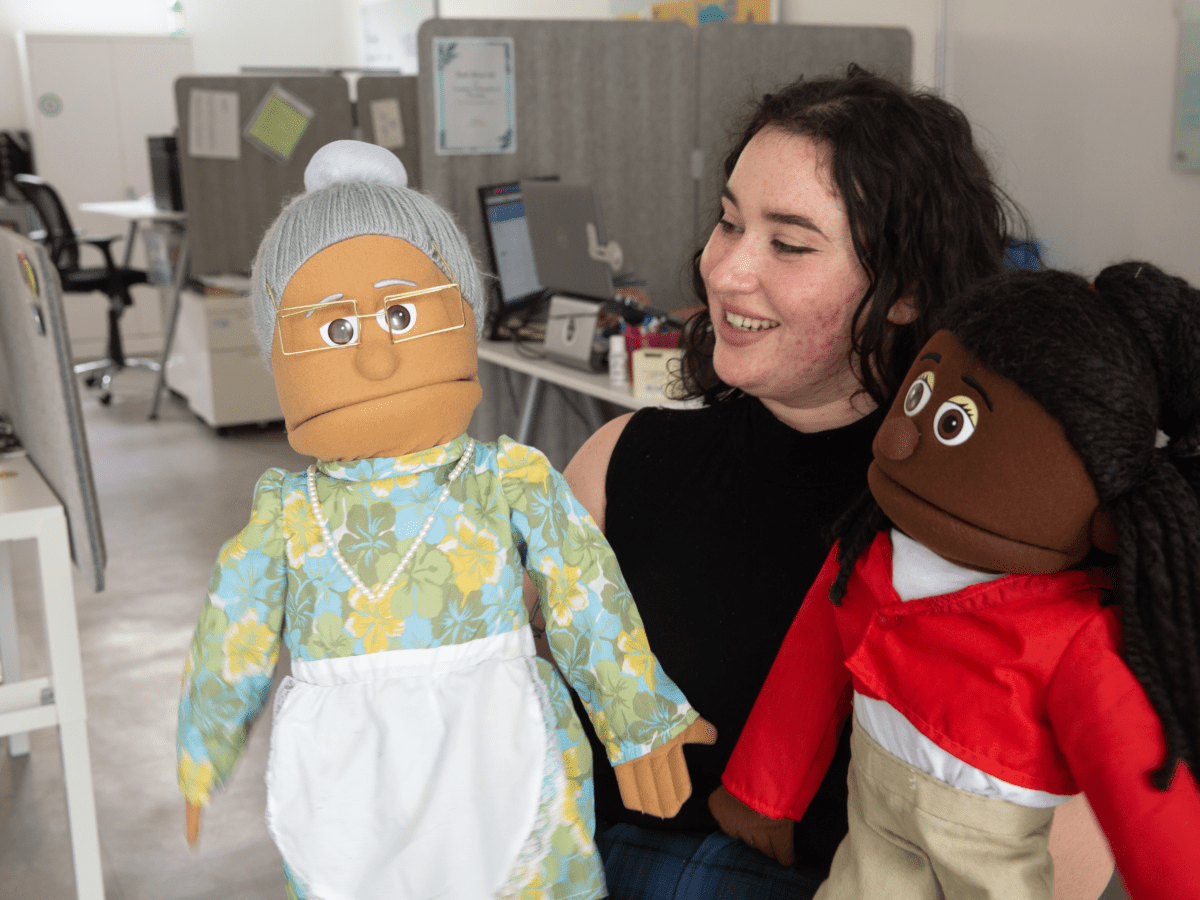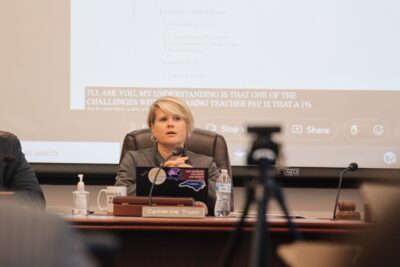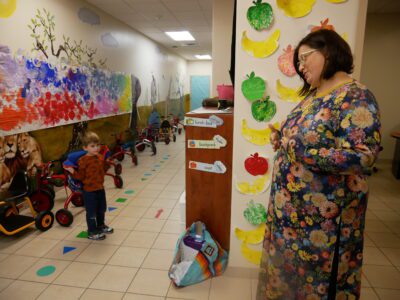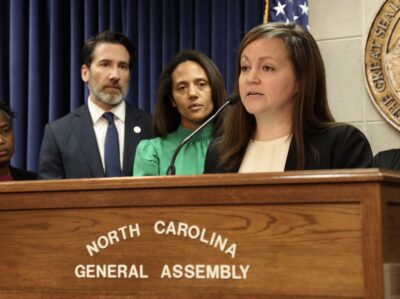
|
|
Editor’s note: This article includes mentions of child sexual abuse.
When Alex Mavrogenis enters a classroom, she steels herself for a fight against a near-invisible crisis: child sexual abuse. The Orange County Rape Crisis Center’s Youth Education Program Coordinator comes armed with “life-saving information” — accompanied by puppets, chants, videos, and a bright smile.
Mavrogenis is running Safe Touch, a child sexual abuse prevention program designed for elementary school students. For more than 40 years, the program has partnered with two local public school districts — Orange County Schools (OCS) and Chapel Hill-Carrboro City Schools (CHCCS) — to bring children information to help keep them safe from sexual abuse.
But now, for the first time in decades, all that has come to a halt.
With the passage of Senate Bill 49 — the controversial, conservative-backed legislation titled the Parents’ Bill of Rights — on Aug. 16, school administrators across North Carolina are grappling with how to best comply with new requirements for their classrooms.
For Safe Touch, this means a pause on a mission decades in the making.
What is Safe Touch?
Established in the 1980s, Safe Touch was developed in response to requests from local guidance counselors seeking support for addressing an influx of student sexual abuse disclosures.
Children across the country are abused at a staggering rate. According to the Centers for Disease Control and Prevention, about 1 in 4 girls and 1 in 13 boys in the United States experience child sexual abuse.
At Safe Touch, statistics like these inform the curriculum in order to reach children at every age and grade level. Students learn to differentiate between safe, unsafe and confusing touches, and they practice strategies of seeking help if they’re touched in an unsafe way.
As students in OCS and CHCCS districts move up each grade, Safe Touch content builds on previously-introduced concepts and evolves to suit their development.
“The messaging is the same,” Mavrogenis said, “but the situations expand to adjust to their real world experiences.”
Once they reach middle school, students will have learned advanced concepts including online safety, understanding and preventing sexual bullying, and how to help peers who are survivors of abuse.
For younger grades, puppet shows, songs, and chants create a giggly crowd of eager participants. For older students, who are often more self-conscious and nervous to share, Safe Touch uses animated videos to appeal to their tech-savvy generation.
Safe Touch also provides a rare opportunity for students to disclose instances of abuse they have faced. The staff is trained to respond to student disclosures, and to recognize and respond to signs of potential abuse (“red flags”) in student behavior. The initiative has been successful. In the 2013-14 school year alone, Mavrogenis said the organization followed up on 12 direct student disclosures of abuse and about 120 red flags, or signs of potential abuse.
Catching child sexual abuse early can be life-saving. According to the CDC, experiencing sexual abuse during childhood can result in various short- and long-term physical, mental, and behavioral health consequences, ranging from physical injuries and post-traumatic stress disorder symptoms, to depression and increased risk of suicide.
“Interrupting and responding to even one case of childhood sexual abuse is something of a measurable success,” Mavrogenis said.
In recent years, Mavrogenis said Safe Touch educators have been able to appear in every classroom of the 18 public elementary schools they work with. In a typical year, she said the program can reach more than 14,000 students.
This year, they haven’t appeared in any of those classrooms.
SB 49: A sudden stop
In September, as Mavrogenis began planning for the school year, she received emails saying that Safe Touch’s partner school districts had placed a temporary pause on the program in order to address the Parents’ Bill of Rights.
The law establishes new guidelines for age-appropriate instruction: “Instruction on gender identity, sexual activity, or sexuality shall not be included in the curriculum provided in grades kindergarten through fourth grade, regardless of whether the information is provided by school personnel or third parties.”
Sen. Amy Galey (R-Alamance), who sponsored SB 49, posted floor remarks addressing the “controversy” surrounding the policy on X, formerly known as Twitter.
“The whole point of the bill is that parents in North Carolina should be empowered to raise their children the way that they see fit in their family without being questioned or interrogated, or undermined by the state of North Carolina,” she said.
“The state must not engage in a conspiracy to prevent parents from knowing important details about the mental health of their children. They should not be kept from having the opportunity to give their children the upbringing that reflects that family’s values.”
Galey did not respond to requests for comment.
Critics of the legislation include Gov. Roy Cooper, who vetoed it in July. The legislature overrode his veto.
“Parents are the most essential educators for their children and their involvement must be encouraged, but this bill will scare teachers into silence by injecting fear and uncertainty into classrooms,” Cooper wrote in a statement. “This ‘Don’t Say Gay’ bill also hampers the important and sometimes lifesaving role of educators as trusted advisers when students have nowhere else to turn.”
Carolyn Halpern, a UNC-Chapel Hill professor and chair of the department of maternal and child health at Gillings School of Global Public Health, said evidence does not support the law’s suggestion that conversations about gender and sexuality are not “age-appropriate” for young children.
“There are studies that have looked at young kids in that age range, and how they respond to gender conversations,” she said. “And the evidence is positive — it’s that they understand it, that it broadens their understanding of people and gender roles and so forth.
“It has to be obviously age-appropriate and developmentally appropriate. But still, it’s possible to do it well, and to be effective in a positive way. And I don’t know of any studies that show any harm from those kinds of programs.”
For Halpern, this “murky” policy language results from a lack of knowledge on the subject matter.
“I guess what’s frustrating is that policy gets passed without the proper homework to understand what the evidence actually is,” she said. “I mean, most of the legislature are not educators, you know, they’re not specialists in developmental health or sexuality.”
Both districts are reviewing the legislation to ensure they’re in compliance with the law before their statewide deadline in January.
With the law passing just as the 2023-24 school year started, Orange County Schools Director of Student Engagement Jessica Dreher said the process of review has been like “building the plane as you fly.”
“We can’t pause school, then figure (SB 49) out, and then implement it,” she said. “We have to keep moving as we make these changes.”
Ahead of the state’s final implementation deadline, Dreher said the decision to pause Safe Touch was not taken lightly at OCS.
“Because we are not at the point yet where we’re at full implementation of that law, it was the best decision to pause, just until we can get full guidance and a full green light on moving forward in some of our programs,” she said.
According to Chief Communications Officer Andy Jenks, the process of review within Chapel Hill-Carrboro City Schools has been similar.
What’s next for Safe Touch?
The complications created by SB 49 have resulted in a “huge barrier” for access to Safe Touch’s prevention and intervention resources, Mavrogenis said.
“I think that what’s really difficult about this news is that there’s children who we would have been able to reach that I don’t know if we’ll be able to reach,” she said. “It’s difficult to stomach.”
The Center for Disease Control (CDC) reports that many children wait to report, or never report their abuse. Even more, 91% of child sexual abuse is perpetrated by someone known and trusted by the child or the child’s family. As a result, the abuse is particularly difficult to detect and address.
To Mavrogenis, the pause is particularly unfortunate, as it disrupts decades of Safe Touch’s consistent, inter-generational effort to prevent child sexual abuse.
“When that process is disrupted, misconceptions and myths about childhood sexual abuse can thrive,” she said. “Children may not get the language that they need to communicate what has happened to them.”
Without access to public schools, the program is seeking new platforms for prevention and intervention resources for both children and adults in the community.
“There’s a couple of initiatives that I really want to put into action, the first of which is creating more social media content and content on our website that’s free and accessible,” Mavrogenis said. “Then also beginning to use community spaces to host our program so that potentially we can reach children that are even outside the public and private school system.”
While the new development has been personally upsetting, Mavrogenis remains determined.
“Crisis happens,” she said. “Obstacles happen that we can’t predict, or we can’t do anything about. And so it’s all about crisis response, in general. It’s all about creativity, and finding ways to meet the needs of your community.”
“It’s the nature of this work,” she said. “We’re adaptive. We’re survivors, and we survive.”






